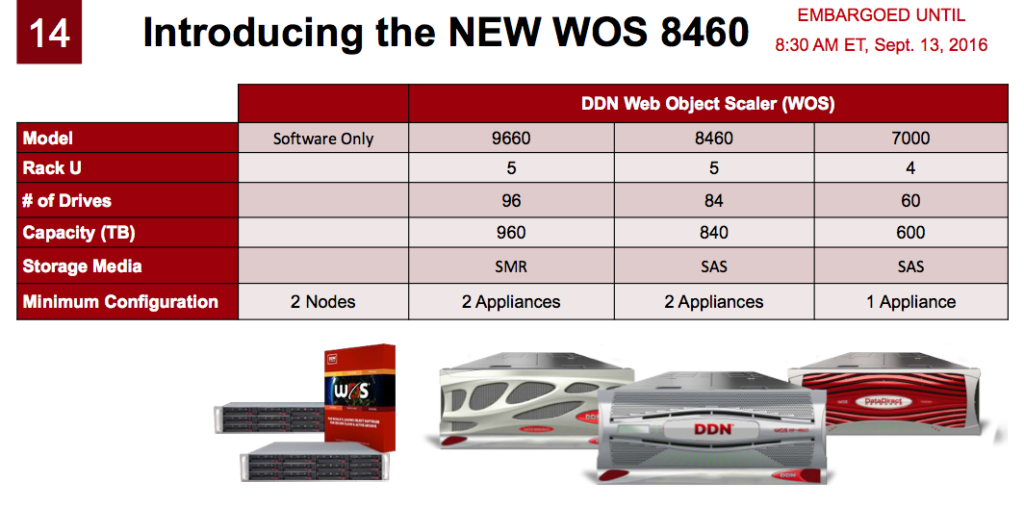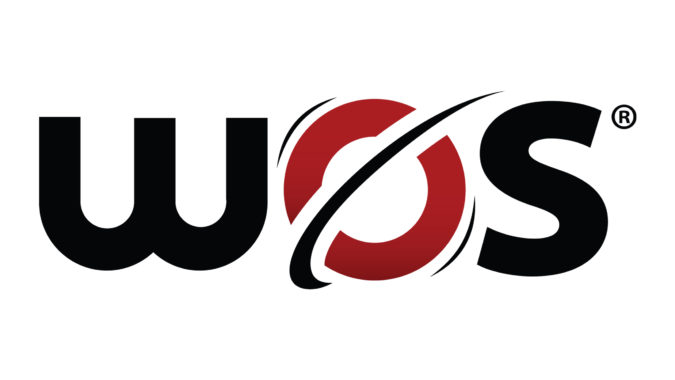DataDirect Networks (DDN) today introduced a third member to its WOS object storage product line, the WOS 8460, aimed at active archive and collaboration use cases. Object storage, once mainly restricted to ‘cold’ archives for large quantities of unstructured data – think content delivery networks (CDN) used in conjunction with the web – has been slowly expanding its footprint into other application areas.
The new DDN product fills out the company’s object storage portfolio and is positioned between DDN’s WOS 9660 offering, intended more for traditional ‘cold’ archives, and WOS 7000, which is well suited for embedded applications such as use with S3. One interesting departure with the WOS product line from DDN’s heritage is willingness to use commodity hardware or third-party hardware generally for its WOS line.
“We have historically been a box company. With WOS, we are aggressively going to market with a software defined offering,” said Kurt Kuckein, senior product manager, DDN, in a pre-launch briefing, “Just in the last year since we announced our emphasis on SDF, we’ve gone from something like two percent of our installed base being software only to well over 10 percent of our WOS installed base. So they are Dell or Supermicro or HPE.
“We have templates for those customers if they want something easy or we will work with them on whatever host-CPU thing they want to use or Lenovo or whatever. You can start very small, a POC initiative that starts really tiny whereas most of the competitive implementations start at a minimum of six nodes and some are as large as 18 to just get off the ground.”
Don’t get the wrong idea. DDN still has a box here and regards its traditional proprietary technology (hardware and software) acumen as a differentiator; Laura Shepard, senior director vertical markets, DDN, was quick to add “you just plug [the 8460] in, turn it on, and give it an IP address and it’s going, whereas there’s a lot more behind the scenes of making the hardware work.”
The new object storage appliance is a single node, 5u offering “that has actually better performance than the WOS 7000. We’re modernizing the network interfaces going with 40 gig over 10gig Ethernet. Most of the boxes today are Ethernet though we have shipped in the past with Infiniband. WOS is pretty agnostic to the underlying technology. The same thing on the drive side – we have had customers who put WOS on FLASH appliances but we don’t ship that way,” she said.
 Object storage, of course, has many attractive features. Its hallmark is use of a single namespace that avoids much of the overhead of hierarchical file-based storage. Finding data, no matter where it resides, is relatively easier. There aren’t complicated directory structures to navigate. Scalability is the other base strength and was very important to object storage’s earliest adopters (media and entertainment). It’s both a strength and weakness that data is generally not changeable.
Object storage, of course, has many attractive features. Its hallmark is use of a single namespace that avoids much of the overhead of hierarchical file-based storage. Finding data, no matter where it resides, is relatively easier. There aren’t complicated directory structures to navigate. Scalability is the other base strength and was very important to object storage’s earliest adopters (media and entertainment). It’s both a strength and weakness that data is generally not changeable.
Except for special uses cases such as CDNs, the common refrain was that object storage was a solution looking for a problem to solve. The rise of big data, mostly unstructured, across many domains combined with the need for collaboration is changing this idea. Life sciences is the poster child active archive use case; large genomic datasets must be efficiently stored and readily accessed from many locations by very many users. Active archive applications constitute much of the target for DDN’s new 8460 product and indeed DDN has compiled several LS use cases (The Scripps Research Institute, The Wellcome Trust Sanger Institute, and Public Health England).
“The object storage market is evolving. You’ve got these hyperscale Web 2.0 folks who’ve been benefiting from the cost and scale of the architecture for some time. What’s happened in the last several years however is that we and others are offering object storage that’s been wrapped [for use with the traditional ecosystem] and we are unlocking a whole new level of use cases,” said Shepard. Indeed, DDN’s WOS sales strategy is around supporting specific use cases, she said as shown below. In HPC and the enterprise, the targets mostly revolve around big data.
 DDN, long a leader in storage for high performance computing (HPC), isn’t new to object storage; its first revenue-producing WOS customer was in the 2009 timeframe reports DDN. Like others, DDN has worked to make object storage deployment easier and virtually all of them emphasizing software defined object storage, which contains costs and enhances flexibility.
DDN, long a leader in storage for high performance computing (HPC), isn’t new to object storage; its first revenue-producing WOS customer was in the 2009 timeframe reports DDN. Like others, DDN has worked to make object storage deployment easier and virtually all of them emphasizing software defined object storage, which contains costs and enhances flexibility.
Addison Snell, CEO Intersect360 Research, characterized the DDN launch as, “using the launch beyond just this appliance as an opportunity to continue delivering its message around what the benefits are for using object storage across the board. The biggest thing to me is that as you get these new types of workloads and more data sources combined with huge storage architectures where people are managing hot storage, cold storage, cloud storage, etc. Object storage can make sense here.”
“It’s important to note DDN is offering a true ‘no file’ system (no-FS) object store. Most suppliers put some sort of a gateway in front of the objects storage, which makes it easier to implement but starts trading off object’s advantages. A major advantage with having a true no-FS is you eliminate much of the file system metadata overhead in tracking where the files are and that reclaims a lot of lost storage. DDN reports that can be as much as 15-20 percent – if you think of having 150 to 200 TB or even petabytes that’s actually a lot of storage,” said Snell.
Most users, including storage administrators, are still more familiar with file-based storage. However, efforts to streamline object storage deployment and management are making inroads. DDN, for example, has built its own native interface with iRODS, which makes it more attractive to the academic and research community. Policy-based, data management, such as through iRODS, is becoming de rigueur for government science grants. Object storage adoption in the broader enterprise arena is still sluggish but gaining as more use cases come to light.
For DDN, said Shepard, object storage is a natural and important opportunity. DDN is targeting specific use case scenarios. “I’m talking about really is big data collaboration. These are things that are proximate to DDN. We are already in the customer site, we are already in the space, we are in the verticals, they know our name. If they are looking for a new archive solutions that might be object based, they are looking at DDN,” said Shepard.
 The HPC storage market is famously fragmented and highly contested. DDN argues it has a several points of competitive differentiation. Its implementation of a true no-FS system is one. Shepard said, “On average when you add the standard block waste for say an HPC center that is doing multiple applications over multiple projects, your block plus your file system is going to come to about 20 percent [of storage capacity]. That’s 20 percent in hard costs on your platters that we can give you back and no one else can.” Without digging deeper, Snell said he thought those numbers sounded reasonable.
The HPC storage market is famously fragmented and highly contested. DDN argues it has a several points of competitive differentiation. Its implementation of a true no-FS system is one. Shepard said, “On average when you add the standard block waste for say an HPC center that is doing multiple applications over multiple projects, your block plus your file system is going to come to about 20 percent [of storage capacity]. That’s 20 percent in hard costs on your platters that we can give you back and no one else can.” Without digging deeper, Snell said he thought those numbers sounded reasonable.
Minimizing data latency is another WOS strength. DDN has built a checking mechanism to choose the copy of the data with least latency, explained Kurt Kuckein, senior product manager, DDN. “It’s going to find the least latent set of your data no matter location proximity or theoretical network bandwidth. So for instance if your most proximal data is sitting right next to you in the datacenter, but is also most proximal to 20,000 other users, while there is a data site that has only ten people accessing it, we’re going to point you to that one but then continue to test to ensure you always have the least latency.”
Data protection is another DDN strength he said, “While erasure coding is kind of the default mechanism for most object storage along with replication for some storage, we do a mix of erasure coding within the box itself, so we can minimize rebuilds over the network and then combine with other erasure codes or with replication to provide that to multiple, multi-site node protections.”
How much of the storage market object storage can capture is unclear. There’s been a lot of talk about the imminent death of parallel files systems currently the workhorse in HPC. Maybe specialized database architectures and aspects of object storage and burst buffer technology will eventually make parallel files systems unnecessary say many. Eventually perhaps but not anytime soon said Shepard. The layer of abstraction represented by files systems is needed today, she contends.






























































